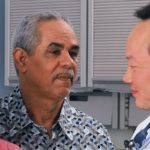1. Among patients with primary Sjögren syndrome, therapy with low-dose interleukin 2 significantly improved outcomes as determined by the European League Against Rheumatism Sjögren’s Syndrome Disease Activity Index.
Evidence Rating Level: 1 (Excellent)
Study Rundown: Primary Sjögren syndrome (pSS) is a debilitating autoimmune disease that is characterized by xerostomia, xerophthalmia, and systemic involvement. While there are currently therapies available for pSS, these are usually corticosteroids and immune-suppressive agents which are used for symptomatic control. These treatment options often are associated with significant adverse effects, and as such, new therapies for pSS are needed. Interleukin 2 (IL-2) is a cytokine which regulates the activity of CD4+ T cells. As dysregulation of T and B cells is involved in the development of pSS, the use of low-dose IL-2 may help improve clinical outcomes in patients with pSS, which this randomized controlled trial aimed to assess. A total of 60 adult participants fulfilling classification criteria for active pSS with at least four weeks of corticosteroid treatments or immunosuppressants were included. Participants were randomly assigned to receive either the blinded recombinant human IL-2 or placebo. Improvement in pSS outcomes were assessed using the European League Against Rheumatism Sjögren’s Syndrome Disease Activity Index (ESSDAI). The results of this study showed that participants in the low-dose IL-2 group had a greater improvement in the ESSDAI compared to participants in the placebo group. As such, this study supports the use of low-dose IL-2 in treating patients with pSS by enhancing function of the regulatory T cells and B cells.
Click here to read this study in JAMA Rheumatology.
Relevant Reading: Low-dose Interleukin-2 can improve salivary secretion but not lymphocyte proliferation of salivary glands in a murine model of Sjögren’s syndrome
In-Depth [randomized controlled trial]: The present data used data from participants between the ages of 18 to 70 who fulfilled the 2002 American-European Consensus Group classification criteria for Primary Sjögren syndrome (pSS). These participants had active disease at the time of inclusion in the study and had at least a four-week history of stable treatment with corticosteroids, nonsteroidal anti-inflammatory drugs, or immunosuppressants. To examine improvements in pSS outcomes, 60 participants were included. Participants were randomly assigned to one of two groups: the placebo group or the recombinant human IL-2, administered for 12 weeks. Change in pSS symptoms, the study’s primary outcome, was assessed through employing the European League Against Rheumatism Sjögren’s Syndrome Disease Activity Index (ESSDAI). The ESSDAI included a total score ranging from 0 to 123 points and examined 12 different domains representing various organ systems. Patient’s ESSDAI was assessed at four weeks, 12 weeks, and 24 weeks. Changes in clinical scores from baseline as well as safety outcomes were examined. Changes in immune cells such as T and B cell subsets were additionally evaluated. Statistical analyses included a logistic regression model which adjusted for age, disease duration, and baseline ESSDAI score. The results of this study showed that patients treated with low-dose IL-2 had greater improvements overall from baseline in ESSDAI scores compared to participants in the placebo group (mean difference -2.47, 95%CI -3.75 to -1.18 points). Clinical symptoms such as dryness, pain, and fatigue, improved more significantly in the IL-2 group compared to placebo. The low-dose IL-2 was well tolerated among most participants. Fewer infections were observed in the low-dose IL-2 group compared with placebo and no serious adverse events were noted. Additionally, immunological analysis reveals that treatment with IL-2 resulted in the expansion of regulatory T cells and B cells. This paper ultimately concludes that use of low-dose IL-2 may be effective in improving treatment outcomes among patients with pSS. However, there are several limitations in this paper that should be noted. For instance, the sample size was quite small with only 60 participants included. Replicating this study among various populations with a larger sample is required before applying these findings into clinical practice. As well, further clinical studies examining varying doses of IL-2 may be needed to discern optimal results. Nevertheless, IL-2 therapy for primary Sjögren syndrome is a promising treatment modality in improving patient outcomes.
Image: PD
©2022 2 Minute Medicine, Inc. All rights reserved. No works may be reproduced without expressed written consent from 2 Minute Medicine, Inc. Inquire about licensing here. No article should be construed as medical advice and is not intended as such by the authors or by 2 Minute Medicine, Inc.


